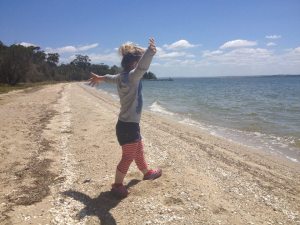
Art as therapy for children
I have lost count of the number of medical appointments that Amelia and I have been to over the last two or so years. Scores of them, I guess. Hearing tests, MRI/CT scans, speech and language assessments and therapy, paediatrician check-ups, blood tests, genetics testing, more hearing tests and so on.
It has been gruelling and demanding to say the least. Banking on the cooperation of your young child in testing environments is an exercise in futility. It’s always a crap shoot, but win, lose or draw, we will be back again for more of the same.
With the recent addition of suspected Autism Spectrum Disorder to the roll call of Amelia’s challenges, we are looking down the barrel of numerous meetings with a child psychologist to help us understand her better. Other intensive therapies are sure to follow.
In the face of all this, it was a strange feeling to have Art therapy suggested to me as a way to reach Amelia and tap into her already burgeoning creative side.
After a pressure-filled six months inside the exhaustive Cochlear Implant Assessment program, I was definitely up for something fun with a ‘no harm, no foul’ feel to it.
Amelia’s sage paediatrician supported this kind of alternative therapy wholeheartedly: “Amelia is an artsy kind of girl, so I think it’s a great idea”.
My acupuncturist (I know, I know) gave me the name of an Expressive Therapist (ditto), JM, who describes her work as: “the recovery, maintenance and development of self-esteem and resilience in children and adolescents”.
“The main aim over four or five sessions using things like Sandplay, Relaxation, Art, Clay Work and Movement is in returning children to their healthy capacity to fully participate positively in their lives as soon as possible”.
Whatever the future holds for Amelia, it was an easy decision to enter into this type of gentle therapy aimed at nurturing her, building her up and maybe helping to free her from the anxiety and rage that sometimes affects her life.
Like Fight Club, the first (and only) ‘rule’ for an Expressive Therapies Session is that usually the parent does not stay with their child. Okay JM, let’s see how we go.
On our way to her house, I continued explaining in detail to Amelia how the morning was going to work and that I would not stay with her unless she wanted me to. Amelia likes lots of preparation before most outings so she is a little armed in advance.
We were welcomed by the delightful JM who took us into her home, with an enormous back room set up like an Aladdin’s cave of artistic delights. Amelia took one look at the shelves and shelves of fascinating ‘stuff’ and chose a small blue fish to hold. Then she grabbed my hand and said, “Mummy go now!”
Wow. I found myself standing on the street two minutes after we’d arrived like a third wheel dismissed for being the boring one. But it was exhilarating. I have become so gun-shy of new experiences that I often find it hard to picture them actually going to plan. But this one did, and a new door opened for Amelia the brave.

Amelia, getting in touch with her artistic side (Dec, 2012)
About an hour later, JM and Amelia came outside to greet me. My girl was the picture of happiness, spinning and laughing and relaxed in JM’s presence. It’s early days, and after one session impossible to know where things will go from here, but I couldn’t have wished for a more positive start.
JM is a warm and intuitive woman. She recognised the depth of Amelia’s interior world, just out of reach for now. She also detected the rage in her and perhaps some grief below it.
It wasn’t easy for me to hear that, but I get that Amelia has suffered ‘losses’ in her own way. Every time she tries to make herself known or understood and we let her down by failing to grasp it, she is frustrated. Maybe that feels like grief inside her growing mind and body.
It was clearly a learning curve for JM too, because deafness can put people a bit on edge, as though communication stops or is hampered when verbal language is largely off the table.
But I don’t think I need to step in as her interpreter. This gig is between them and I’m excited to see how they’ll work it out. For once I am not required and that is a blessed relief.
The drive home was one of our most relaxed for years. No screaming from the backseat or worrying in the front over bad news just received.
I put the window down to feel the wind and the good vibes and looked forward to next week. Bring on session number two.






